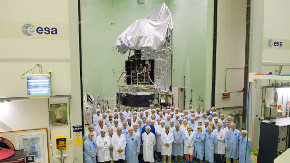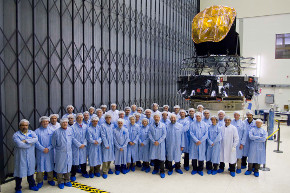Herschel and Planck honoured with Space Systems Award
2 September 2015
The Herschel and Planck project teams are this year's recipients of the American Institute of Aeronautics and Astronautics Space Systems Award.This award is presented annually by the AIAA to recognize outstanding achievements in the architecture, analysis, design, and implementation of space systems.
The Herschel and Planck project teams have been cited for "outstanding scientific achievements recognized by the worldwide scientific community and for outstanding technical performances of the two satellites."
Reacting to the news of this award, Thomas Passvogel, Herschel and Planck Programme Manager from 2000 until 2009, says:
"I am delighted that the AIAA has chosen to honour the Herschel and Planck project teams with this prestigious award, and very proud of what the teams achieved with all of our colleagues from industry and scientific institutes across Europe and beyond.
"The Herschel and Planck spacecraft were technically challenging endeavours but our teams were up to the challenge and as we see from the excellent science that is coming from both missions, we managed to achieve what we set out to do: to provide the science community with world-class, ground-breaking spacecraft."
The award will be presented on 2 September during the AIAA Space and Astronautics Forum and Exposition, in Pasadena, California.
About Herschel
 |
| Members of the Herschel project team with the spacecraft, June 2008. Credit: ESA-A. Le Floc'h |
The Herschel infrared space observatory, which operated from May 2009 until April 2013, carried the largest telescope ever built for a space observatory. Its 3.5 m-diameter primary mirror collected long-wavelength radiation from some of the coldest and most distant objects in the Universe, which was analysed with a payload of three scientific instruments.
To observe these very cold regions with high sensitivity Herschel’s instruments needed to be cryogenically cooled to a temperature only a few degrees above absolute zero. By the time that the superfluid helium that was needed to maintain this ultra-cool environment ran out, the observatory had carried out over 40,000 scientific observations, during more than 25,000 hours. All these scientific observations made by Herschel have been publicly available for use by astronomers across the globe since late 2013.
Göran Pilbratt, Herschel Project Scientist says: "The remarkable scientific harvest from Herschel is a tribute to the excellent work of the teams who nurtured the observatory from the early concept phases through development and launch, right up until the final moment of scientific operations, and even continuing now in the post-operations phase. The science community continues to benefit from this legacy of engineering excellence."
About Planck
 |
| Members of the Planck project team with the spacecraft, April 2008. Credit: ESA-A. Le Floc'h |
Planck was designed to probe with the highest accuracy ever achieved, the remnants of the radiation that filled the Universe immediately after the Big Bang – what we observe today as the Cosmic Microwave Background. It did this with a payload of two instruments that required innovative cooling technology to maintain them at a fraction of a degree above absolute zero.
Originally targeted to complete two whole surveys of the sky following launch in May 2009, Planck exceeded this goal and by the time the mission was completed in October 2013 it managed five full-sky surveys with both instruments as well as three more with only one of the instruments.
Data from Planck are helping to provide answers to some of the most important questions in modern science: how did the Universe begin, how did it evolve to the state we observe today, and how will it continue to evolve in the future? These data are now publicly available for anyone to use for their own research.
Jan Tauber, Planck Project Scientist says: "The innovation and expertise that characterised the project teams’ approach to the Planck mission reaped huge benefits when we were able to far exceed our expectations and survey the entire sky many times more than our original goal. The bountiful data that this yielded is giving us the best insight yet into the earliest moments of our cosmos."
Contacts
Thomas Passvogel
Herschel and Planck Programme Manager, and
Head of Projects Department
Directorate of Science and Robotic Exploration
ESA, The Netherlands
Email: Thomas.Passvogel![]() esa.int
esa.int
Phone: +31-71-565-5962
Göran Pilbratt
Herschel Project Scientist
Scientific Support Office
Directorate of Science and Robotic Exploration
ESA, The Netherlands
Email: gpilbratt![]() cosmos.esa.int
cosmos.esa.int
Phone: +31-71-565-3621
Jan Tauber
Planck Project Scientist
Scientific Support Office
Directorate of Science and Robotic Exploration
ESA, The Netherlands
Email: jtauber![]() cosmos.esa.int
cosmos.esa.int
Phone: +31-71-565-5342




